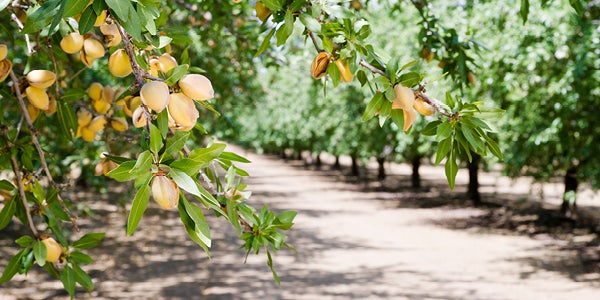Exercise bikes and computer chips can wait on ships for weeks, but nuts and fruits have a more limited window. How can agribusiness owners better prepare for 2022?
Fewer chestnuts roasted over open fires this holiday season. While the global shipping crisis has made it difficult to import needed materials, exporting finished products has become just as tedious. The California nut industry saw a massive drop-off in exports at the end of 2021. In the fall of 2021, walnut producers exported 47% fewer nuts in the shell and 16% fewer shelled nuts than the same season in 2020. Furthermore, almonds experienced a 19% drop in exports around the same time.
American farmers are feeling the financial sting of the ongoing shipping crisis. Exercise bikes and computer chips can wait on ships for weeks, but nuts and fruits have a more limited window. How can agribusiness owners better prepare for the upcoming season? Will the shipping crisis continue to disrupt imports and exports in the coming year?
Expert Comments on What's Happening With Nut Exports
Many Americans tend to focus on imports when discussing the ongoing shipping crisis. However, American exports have taken blow after blow as shipping companies race back to Asia with empty containers. It's simple economics—the voyage from Asia to California is more profitable than the reverse. Unfortunately, American agribusiness suffers as a result.
According to Roger Isom, President and CEO of the California Cotton Ginners and Growers Association and the Western Agricultural Processors Association, 80% of scheduled tree nut shipments were canceled in October 2021. These cancellations can do irreparable damage to a grower’s bottom line. An industry that exported more than $8.1 billion worth of goods in 2019 can't afford these rampant cancellations.
Isom pointed specifically to walnuts, which are always in high demand during the holiday season. Europeans frequently use walnuts for desserts, candies, and other holiday treats. If they can't get them from America, they'll get them from someone else. One year of lost business is already catastrophic, but losing such a reliable client can shake the entire operation to its core.

However, the resilience of American agriculture thus far remains impressive. When 80% of West Coast shipments were canceled, producers resorted to sending their goods by train to ports in Maryland and Texas. Although more costly, anything is better than watching fresh product rot while it waits to board in California. But how long will American agribusiness have to deal with the congestion?
A Look at the Shipping Crisis Worldwide
The shipping crisis has left its mark on every industry. The current crisis’ roots trace back to the beginning of the Covid-19 pandemic, but the dominos are still falling today. At the start of the pandemic, global shutdowns forced many manufacturers to close their factories. Business owners accounted for the expected drop-off in demand; however, a spike in eCommerce purchases (driven by many spending down their savings or stimulus money) forced demand to skyrocket unexpectedly.
Since most companies relied on just-in-time manufacturing, there was little to no stock of excess goods and components. Every subsequent link in the supply chain had to wait for its predecessor to produce the goods they needed. And once exporters finally got their products to port, the labor shortage extended the time needed to load and unload these vessels. Before Covid, it took only a few days to unload a ship. Now, it takes weeks.
This raises the earlier question of port profit, and how shipping companies choose where to dock. Shipping costs are so high now that many hurry back to Asia to repeat the more profitable westbound trip. Before, these ships would stop in a smaller port in Oakland, where most of California's tree nuts ship from. Port of Oakland director Danny Wan mentioned how his port had empty terminals, void of both containers and ships. Meanwhile, 87 boats waited to dock in Southern California.
How Do Farm Owners Plan Going Forward?
Many experts believe the current shipping crisis will continue well into 2022, and possibly bleed into 2023. Several Covid-related factors play into these predictions, as countries shutter production to combat spikes in new cases. Furthermore, China continues to implement strict Covid-19 policies, which cause continued port disruption.
The rising cost of shipping is finally catching the attention of American economists and inflation watchers, who rarely factored transportations costs into their calculations. Before the pandemic, it cost approximately $1300 to ship a 40-foot container across the Pacific Ocean, according to the Freightos FBX index. That same container topped record levels near the end of 2021, reaching $11,000 in some cases and climbing as high as $25,000 in others.
Will those costs taper off soon? Some experts don't believe so. "This means the higher cost of logistics is not a transitory phenomenon," said Peter Sand, a chief analyst for Xeneta, a freight rate benchmarking platform. "For inflation, that means trouble... The element of shipping, in overall prices, small as it may be, is much bigger than ever before, and it could be a permanent lift to prices going forward," he continued.

With shipping taking such a large chunk out of their bottom line, some American farmers pivoted to transporting product domestically. Some California rice exporters have adopted break-bulk shipments, among other transportation needs. Others plan on shipping more products out of ports in Houston and on the East Coast. They might even begin holding inventory overseas, to avoid future shipping congestion. While overseas warehouses carry their own risk, it's becoming a necessary strategy to combat the ongoing shipping crisis.
For American agribusiness, proper long-term and fact-driven thinking is the key to economic success in uncertain times. As the cost of shipping spikes, consulting with an expert financial partner such as Premier Valley Bank, a division of HTLF Bank could help nut farmers adequately forecast and manage cash flow.
Plan Strategies Today For Tomorrow’s Market
Industry experts don't have the most positive outlook for the ongoing shipping crisis. As American agribusiness continues to struggle through the current environment, nut producers would benefit by having a reliable financial partner like Premier Valley Bank, a division of HTLF Bank to help navigate the ever-changing times. Their specialized agribusiness team can help alleviate some of the risk and uncertainty by providing working capital, tools to assist with cash flow and other solutions to help you focus on keeping your business moving forward, especially when the shipping challenges decrease.

